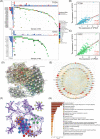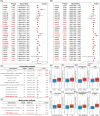VPS72, a member of VPS protein family, can be used as a new prognostic marker for hepatocellular carcinoma
- PMID: 37249275
- PMCID: PMC10201960
- DOI: 10.1002/iid3.856
VPS72, a member of VPS protein family, can be used as a new prognostic marker for hepatocellular carcinoma
Abstract
Background: Vacuolar protein sorting (VPS) plays a crucial role in intracellular molecular transport between organelles. However, studies have indicated a correlation between VPSs and tumorigenesis and the development of several cancers. Nevertheless, the association between VPSs and hepatocellular carcinoma (HCC) remains unclear.
Methods: By analyzing databases such as The Cancer Genome Atlas (TCGA) and The International Cancer Genome Consortium (ICGC), we investigated the differences in VPSs expression between normal tissue and HCC transcriptomes. Furthermore, we examined the relationship between VPSs expression and overall survival (OS) in patients with HCC. Univariate and multivariate Cox analyses were employed to assess the prognostic value of VPS72 as an independent factor, and the correlation between VPS72 and the tumor immune microenvironment was also analyzed.
Results: We observed significant overexpression of 28 VPSs in HCC tissues compared to normal tissues. The mRNA expression of VPSs displayed a negative correlation with OS, while exhibiting a positive correlation with tumor grade and stage. Additionally, both univariate and multivariate Cox analyses identified VPS72 as a potential independent risk factor for HCC prognosis. Overexpression of VPS72 demonstrated a positive correlation with various clinicopathological factors associated with poor prognosis, as well as the infiltration levels of immune cells.
Conclusion: Therefore, our research shows that VPSs participate in HCC occurrence and development, especially VPS72, which may act as a potential target for HCC treatment and prognosis biomarker.
Keywords: VPS72; bioinformatics; hepatocellular carcinoma; vacuolar protein sorting family.
© 2023 The Authors. Immunity, Inflammation and Disease published by John Wiley & Sons Ltd.
Conflict of interest statement
The authors declare no competing interests.
Figures






Similar articles
-
Vacuolar protein sorting-associated protein 72 homolog (VPS72) binding to lysine acetyltransferase 5 (KAT5) promotes the proliferation, invasion and migration of hepatocellular carcinoma through regulating phosphatidylinositol 3-kinase (PI3K)/protein kinase B (AKT) signaling pathway.Bioengineered. 2022 Apr;13(4):9197-9210. doi: 10.1080/21655979.2022.2056692. Bioengineered. 2022. PMID: 35383533 Free PMC article.
-
Identification of Rad51 as a prognostic biomarker correlated with immune infiltration in hepatocellular carcinoma.Bioengineered. 2021 Dec;12(1):2664-2675. doi: 10.1080/21655979.2021.1938470. Bioengineered. 2021. PMID: 34115569 Free PMC article.
-
High expression of PDZ-binding kinase is correlated with poor prognosis and immune infiltrates in hepatocellular carcinoma.World J Surg Oncol. 2022 Jan 22;20(1):22. doi: 10.1186/s12957-021-02479-w. World J Surg Oncol. 2022. PMID: 35065633 Free PMC article.
-
Overexpression of Ribosomal Protein S6 Kinase A4 (RPS6KA4) Predicts a Poor Prognosis in Hepatocellular Carcinoma Patients: A Study Based on TCGA Samples.Comb Chem High Throughput Screen. 2022;25(13):2165-2179. doi: 10.2174/1386207325666220301105850. Comb Chem High Throughput Screen. 2022. PMID: 35232347
-
Comprehensive analysis and validation of SNX7 as a novel biomarker for the diagnosis, prognosis, and prediction of chemotherapy and immunotherapy response in hepatocellular carcinoma.BMC Cancer. 2023 Sep 25;23(1):899. doi: 10.1186/s12885-023-11405-0. BMC Cancer. 2023. PMID: 37743471 Free PMC article.
Cited by
-
Expression Analysis of VPS72 and Associated Biological Behaviors in Colon Cancer.Int J Gen Med. 2024 Aug 8;17:3433-3442. doi: 10.2147/IJGM.S465064. eCollection 2024. Int J Gen Med. 2024. PMID: 39135633 Free PMC article.
-
Identification of tumor immune infiltration-associated VPS72 and prognostic significance of VPS72 and CD8A in hepatocellular carcinoma.Discov Oncol. 2025 Mar 27;16(1):410. doi: 10.1007/s12672-025-02017-0. Discov Oncol. 2025. PMID: 40146476 Free PMC article.
-
Prognostic marker VPS72 could promote the malignant progression of prostate cancer.BMC Cancer. 2024 Jun 10;24(1):713. doi: 10.1186/s12885-024-12488-z. BMC Cancer. 2024. PMID: 38858662 Free PMC article.
-
In vivo CRISPR Activation Screening, a Powerful Tool to Discover Oncogenic Driver Genes in Hepatocellular Carcinoma.Cell Mol Gastroenterol Hepatol. 2025;19(5):101459. doi: 10.1016/j.jcmgh.2024.101459. Epub 2025 Jan 21. Cell Mol Gastroenterol Hepatol. 2025. PMID: 39855631 Free PMC article. No abstract available.
References
MeSH terms
Substances
LinkOut - more resources
Full Text Sources
Medical

